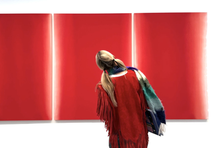La Bourse de Commerce: The Museum that is Taking Paris by Storm
- The Courtauldian
- Nov 19, 2023
- 4 min read
Updated: Nov 20, 2023
By Mathilda Drukier
The Bourse de Commerce, which recently took over Paris in May 2021, is François Pinault’s third museum (Palazzo Grassi and Punta della Dogana in Venice being the other two). It displays the work of some of the world’s leading contemporary artists. The museum’s opening was like a breath of fresh air following multiple lockdowns. With its location between the Pompidou Centre and the Louvre, the museum quickly established itself as one of Paris’ prominent collections of contemporary art. Since its opening, the museum has featured some amazing artists such as Cindy Sherman, Richard Prince, Lynette Yiadom-Boakye, Kerry James Marshall, and Anika Yi. It is a museum that I always want to go back to when I visit home. Currently on display is the colorful and luminous Mike Kelly exhibition which is plastered all over the metro and is impossible to avoid. I originally wanted to revue this exhibition; however, I now find myself wanting to look at the totality of its collection, which although have only been active in Paris for two years, is a central part of the Parisian art scene’s fabric.
The museum building itself is rich in history despite the very modern interior designed by ex-boxer Tadao Ando, who’s star feature is its “Rotonde” (a large concrete cylinder with a 33-meter diameter in the museum’s centre) which displays the work of a series of artists. The Rotonde is the feature that makes the Bourse de Commerce standout, with its large circular space being at the heart of the museum and capable of accommodating any type of media, whether it be installation, sculptures, films, or even AI. The museum has kept certain historical features of the historical building too, being labelled as a “palimpsest” by the museum director due to its ability to keep elements from its past. The museum was once a granary store and was turned into the Commodities Stock Exchange (Bourse de Commerce) for the 1889 Universal exhibition. These features have all been left in the design of the museum as it has anchored itself in the fabric of Paris.
The museum’s opening will always be one of the most visually stunning exhibitions, showing the range of the Pinault Collection. It marked the Bourse de Commerce’s place within the Paris art scene making it one of the forefront art collections in Europe. I will always remember seeing Urs Fischer’s work, a giant wax candle sculpture of the Abduction of the Sabine women by Bernini. The work manages to pull together the older Baroque style of Bernini and combine it with the playful and impermanent style of contemporary art. It also invited viewers to come back to see the work over its time and bear witness to its fleeting performance. This idea of a sort of audience participation, encouraging audiences to come back and visit the works, would set the tone for the museum with its constantly changing exhibitions and shifting displays that show the limitless possibilities for contemporary art.

Urs Fischer, Untitled, Wax, 2011-2020. View of artwork in situ, La Bourse de Commerce, photographed by Stefan Altenburger.
This year the collection has featured the works of Tacita Dean, Mike Kelly, and Danh Vo. Mike Kelly’s different colourful and vibrant versions of Superman’s Kandor city are presented in an intimate setting. Kelly plays with ideas of Sylvia Plath’s Bell Jar, placing the glass covers for these cities next to them, and engaged with the idea of isolation experienced by both Superman and Plath. We loom like giants over these small cities which are disconnected from each other, surrounded by complete and total darkness outside of the light which emerges from these cities. The exhibition continues with other works of the artist in different medias: films, moving sculptures, murals, photography, showing the versatility of the artist. It is definitely worth visiting if you are in Paris before February 19th, 2024.
However, it was Dahn Vo’s use of the Rotonde in his work, Tropeaolum, that has truly stuck with me during the exhibition ‘Before the Storm.’ The use of different types of wood to create a large structure that people can step through and be a part of, invited us into the world of the Vietnamese-Danish artist. Although many artists have displayed in the Rotonde since Urs Fischer, none have made use of the space as well as Vo, playing with its scale and monumentality. During its display time, flowers would bloom on the wood, as the more constructed wooden frames contrasted with the live tree branches. The artist has quite literally created a forest, interweaving his family’s past and immigration from Vietnam to Europe through the display of old letters and photographs that have been framed and nailed to the wooden beams. The wood in Tropeaolum comes from oak trees that have been destroyed in storms and selected by the National Forest Department. These come from the forests of Craig McNamara, the son of Robert McNamara, who was the US Secretary of Defense and an ‘architect of the Vietnam War’ which would lead to Vo’s family fleeing to Denmark. Through these various fragments of the past and present, he created a work that parallels the historically layered nature of the building. It shows that Pinault’s Bourse de Commerce has created a new defining layer in the building, encouraging artists to come use the space and layer their own history over it.
I look forward to seeing what the museum will display in the future and would recommend this museum to anyone visiting France’s capital city. It will give you the best combination of old Parisian architecture and contemporary global art all in one!

Danh Vo, Tropeaolum, multimedia, 2023. View of artwork in situ, La Bourse de Commerce, photographed by Danh Vo.












Comments